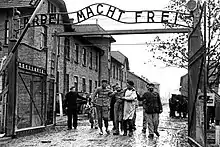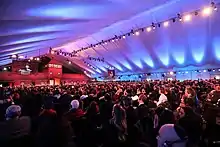Liberation of Auschwitz concentration camp
On 27 January 1945, Auschwitz concentration camp—a Nazi concentration camp where more than a million people were murdered—was liberated by the Red Army during the Vistula–Oder Offensive. Although most of the prisoners had been forced onto a death march, about 7,000 had been left behind. The Soviet soldiers attempted to help the survivors and were shocked at the scale of Nazi crimes. The date is recognized as International Holocaust Remembrance Day.

Background
Between 1940 and 1945, about 1.3 million people (mostly Jews) were deported to Auschwitz by Nazi Germany; 1.1 million were murdered.[1] In August 1944, there were more than 135,000 prisoners across the complex.[2] In January 1945, after the Red Army launched the Vistula–Oder Offensive and approached the camp, almost 60,000 prisoners were forced to leave on a death march westward.[1][3] Inmates were marched mostly to Loslau but also to Gleiwitz,[4] where they were forced into Holocaust trains and transported to concentration camps in Germany.[5] However, the liberation of the camp was not a specific goal of the Red Army and happened as a consequence of their advance westward across Poland.[6] The Red Army had already liberated concentration camps in the Baltic area in early- to mid-1944, and other concentration camps continued to be liberated until the German surrender and the end of World War II in Europe in May 1945.[7]
Liberation
Red Army soldiers from the 322nd Rifle Division arrived at Auschwitz on 27 January 1945 at 15:00.[8][9] Two hundred and thirty-one Red Army soldiers died in the fighting around Monowitz concentration camp, Birkenau, and Auschwitz I, as well as the towns of Oświęcim and Brzezinka.[10][11] For most of the survivors, there was no definite moment of liberation. After the death march away from the camp, the SS-TV guards had left.[12]
About 7,000 prisoners had been left behind, most of whom were seriously ill due to the effects of their imprisonment.[1] Most of those left behind were middle-aged adults or children younger than 15.[13] Red Army soldiers also found 600 corpses, 370,000 men's suits, 837,000 articles of women's clothing, and seven tonnes (7.7 tons) of human hair.[8] At Monowitz camp, there were about 800 survivors and the camp was liberated also on 27 January by the Soviet 60th Army, part of the 1st Ukrainian Front.[14]
Battle-hardened soldiers who were used to death were shocked by the Nazis' treatment of prisoners. Red Army general Vasily Petrenko, commander of the 107th Infantry Division, remarked, "I who saw people dying every day was shocked by the Nazis' indescribable hatred toward the inmates who had turned into living skeletons. I read about the Nazis' treatment of Jews in various leaflets, but there was nothing about the Nazis' treatment of women, children, and old men. It was in Auschwitz that I found out about the fate of the Jews."[6] In a few articles in Soviet newspapers such as Pravda, following Soviet propaganda, the writers failed to mention Jews in their articles on the liberation.[6][15]
As soon as they arrived, the liberating forces (assisted by the Polish Red Cross) tried to help survivors by organizing medical care and food; Red Army hospitals cared for 4,500 survivors. There were also efforts to document the camp.[16] As late as June 1945, there were still 300 survivors at the camp who were too weak to be moved.[17]
Commemoration

The date of the liberation (27 January) is recognized by the United Nations and the European Union as International Holocaust Remembrance Day.[18][19] On the 75th anniversary (2020), a forum of world leaders—the World Holocaust Forum—was held in Israel, hosted by President Reuven Rivlin. Among the attendees were United States Speaker of the House Nancy Pelosi, President of Russia Vladimir Putin, Charles, Prince of Wales, President of Germany Frank-Walter Steinmeier, and President of Ukraine Volodymyr Zelensky.[20]
References
- "Online Exhibition — the liberation of Auschwitz". United States Holocaust Memorial Museum. Retrieved 21 January 2020.
- Wachsmann 2015, p. 1771.
- "The cessation of mass extermination / Evacuation / History / Auschwitz-Birkenau". Auschwitz-Birkenau State Museum. Retrieved 21 January 2020.
- Hojka & Kulpa 2016, p. 8.
- Piper 2009, p. 212.
- Stone 2015, p. 46.
- Wachsmann 2015, pp. 1767, 1772.
- "What a Soviet soldier saw when his unit liberated Auschwitz 70 years ago". The Washington Post. 27 January 1945. Retrieved 21 January 2020.
- Wachsmann 2015, p. 1770.
- Strzelecki 2001, p. 220.
- Stone 2015, p. 44.
- Stone 2015, p. 30.
- Stone 2015, p. 47.
- Schmaltz 2009, p. 218.
- Wachsmann 2015, p. 33.
- Stone 2015, pp. 46–47.
- Stone 2015, p. 48.
- "The European Union and Holocaust remembrance" (PDF). European Parliament. Retrieved 21 January 2020.
- "International Holocaust Remembrance Day". United States Holocaust Memorial Museum. Retrieved 21 January 2020.
- Gross, Judah Ari. "With 10,000 officers, police gear up to protect massive Holocaust commemoration". Times of Israel. Retrieved 21 January 2020.
Sources
- Hojka, Piotr; Kulpa, Sławomir (2016). Kierunek Loslau. Marsz ewakuacyjny więźniów oświęcimskich w styczniu 1945 r. (in Polish). Wodzisław Śląski: Museum in Wodzisław Śląski. ISBN 978-83-927256-0-2.
- Piper, Frantiszek (2009). "Auschwitz II-Birkenau". In Megargee, Geoffrey P. (ed.). Early Camps, Youth Camps, and Concentration Camps and Subcamps under the SS-Business Administration Main Office (WVHA). Encyclopedia of Camps and Ghettos, 1933–1945. 1. Bloomington: United States Holocaust Memorial Museum. pp. 209–214. ISBN 978-0-253-35328-3.
- Schmaltz, Florian (2009). "Monowitz". In Megargee, Geoffrey P. (ed.). Early Camps, Youth Camps, and Concentration Camps and Subcamps under the SS-Business Administration Main Office (WVHA). Encyclopedia of Camps and Ghettos, 1933–1945. 1. Bloomington: United States Holocaust Memorial Museum. pp. 215–220. ISBN 978-0-253-35328-3.
- Stone, Dan (2015). The Liberation of the Camps: The End of the Holocaust and Its Aftermath. New Haven: Yale University Press. ISBN 978-0-300-21603-5.
- Strzelecki, Andrzej (2001). The Evacuation, Dismantling and Liberation of KL Auschwitz. Oświęcim: Auschwitz-Birkenau State Museum. ISBN 978-83-85047-95-7.
- Wachsmann, Nikolaus (2015). KL: A History of the Nazi Concentration Camps. London: Macmillan. ISBN 9780374118259.